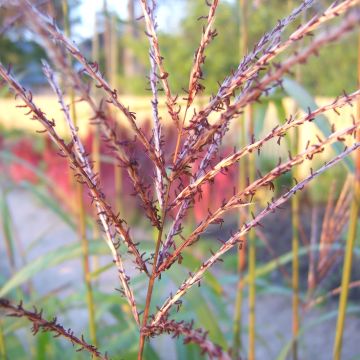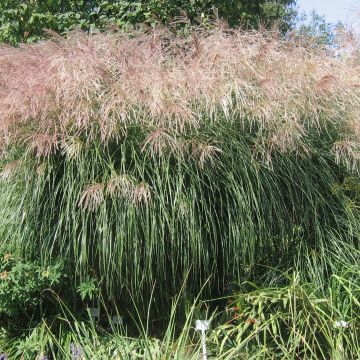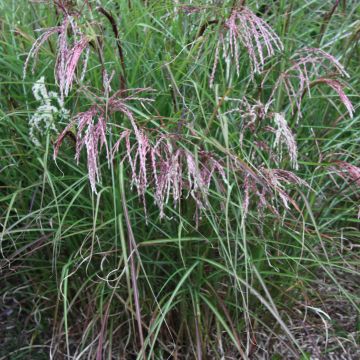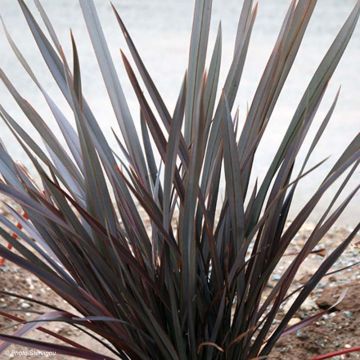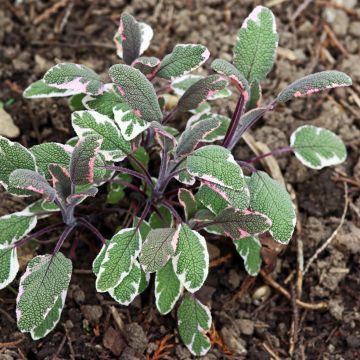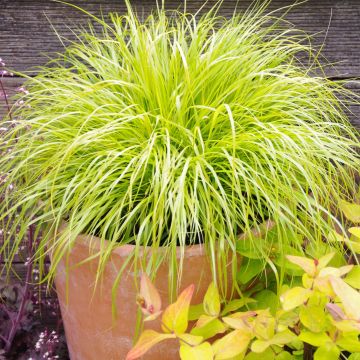

Miscanthus sinensis Gold Bar - Silvergrass
Miscanthus sinensis Gold Bar - Silvergrass
Miscanthus sinensis Gold Bar
Eulalia, Porcupine Grass, Chinese silver Grass, Maiden Grass, Zebra Grass, Susuki Grass
This item cannot be shipped to the selected country
Delivery charge from €5.90
Delivery charge from €5.90
More information
Schedule delivery date,
and select date in basket
This plant carries a 12 months recovery warranty
More information
We guarantee the quality of our plants for a full growing cycle, and will replace at our expense any plant that fails to recover under normal climatic and planting conditions.
From €5.90 for pickup delivery and €6.90 for home delivery
Express home delivery from €8.90.
From €5.90 for pickup delivery and €6.90 for home delivery
Express home delivery from €8.90.
Does this plant fit my garden?
Set up your Plantfit profile →
Description
Miscanthus sinensis 'Gold Bar' is a dazzling Chinese Reed. It is a modest-sized variety, completely striped with gold. It is a marvel for small gardens. This grass slowly forms an upright and compact clump, densely leafy, with each ribbon regularly marked with cream-yellow lines across its width. The plume-like inflorescences turn a dark red shade over time. Compact and slow-growing, this unique grass will find its place on a balcony or patio, or prominently planted in a well-kept flower bed.
'Gold Bar' belongs to the Poaceae family. Close to the 'Zebrinus' variety, it is a horticultural selection derived from Miscanthus sinensis, native to East Asia and Oceania. This perennial grass with short rhizomes grows in a non-spreading, tufted clump. The upright habit does not exceed 80cm (32in) in height, with a spread of 40cm (16in). The leaves are thin and ribbon-like. They are very long, slightly stiff, and dark green with light yellow stripes. The floral stems emerge just above the foliage from September to November, in the form of digitate and silky spikes, 15 to 20cm (6 to 8in) long. They are pinkish-beige at first. As they fade, they turn a burgundy shade. The plumes consist of tiny flowers that close afterwards, only to open again at maturity. They then take on a fluffier appearance.
Miscanthus is probably one of the most beautiful and least invasive of ornamental grass. It has been the subject of numerous selections and is the origin of many cultivars. They all share the same silhouette, with an upright, regular, and arched clump. They all have long leaves with a light central stripe, turning a straw-yellow colour in winter. It is a wonderful perennial that grows on its own, perfect for contemplative gardeners, and has its place in a modern garden with clean lines, or in large ensembles where it will lighten flowering. Miscanthus sinensis 'Gold Bar' should be highlighted in flower beds. Its strong personality will bring a beautiful structure and originality to the garden. In winter, just like conifers, it lights up the garden with its reassuring silhouette. In an urban garden, it will soften concrete structures. Its size allows it to fit in small gardens or even be grown in a pot on a patio or balcony.
Report an error about the product description
Miscanthus sinensis Gold Bar - Silvergrass in pictures
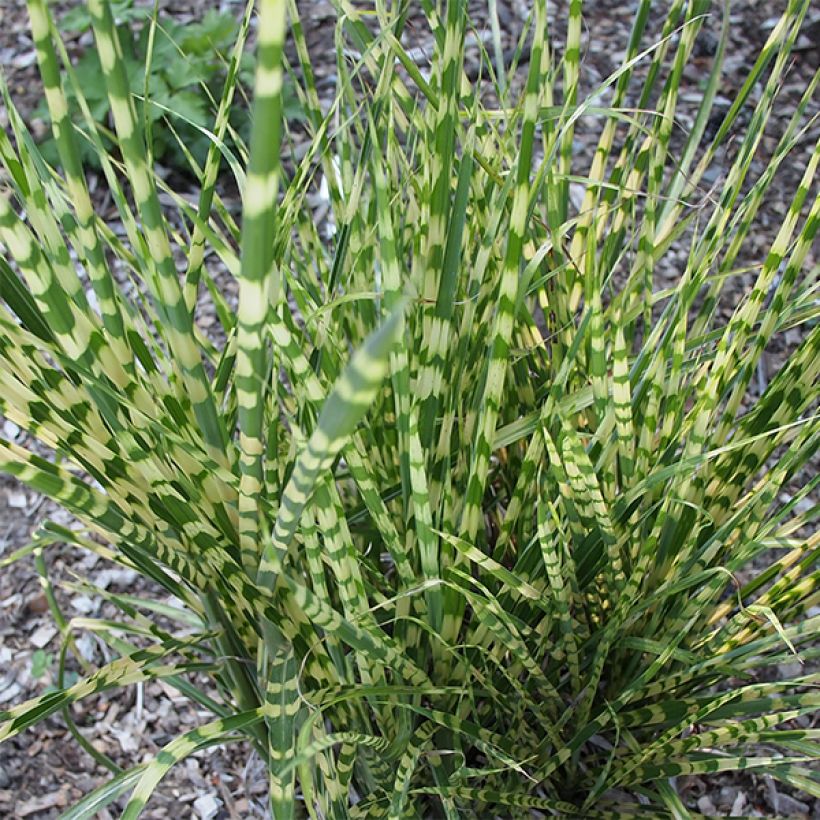



Flowering
Foliage
Plant habit
Botanical data
Miscanthus
sinensis
Gold Bar
Poaceae
Eulalia, Porcupine Grass, Chinese silver Grass, Maiden Grass, Zebra Grass, Susuki Grass
Cultivar or hybrid
Other Miscanthus
Planting and care
Miscanthus sinensis 'Gold Bar' thrives in warm exposures and healthy, not too rich, deep , well-drained soil that remains moist in summer. It does not like stagnant humidity in winter. Soil that is too rich can encourage lush vegetation at the expense of flowers. Spring compost application can be beneficial in very poor soils. This plant tolerates occasional drought if the soil is deep. It can adapt to poor soil, but it will be less imposing and its growth slower. Warm-climate grasses such as Miscanthus, Panicum, and Pennisetum develop in late spring, bloom after mid-summer, and are usually cut back in late winter. Therefore, plant them in spring, after the strongest frosts have passed. Miscanthus are good plants for containers. For container planting, choose a large container (minimum 45L), filled with a fertile, well-draining, and flexible growing medium. A mixture composed of 20% good garden soil, 20% mix of draining elements (pumice or gravel or coarse river sand), and 60% horticultural compost will be perfect. Apply well-decomposed compost once or twice a year (late winter and autumn) or slow-release fertiliser. When it becomes less floriferous, divide the clump and replant the peripheral shoots.
Planting period
Intended location
Care
-
, onOrder confirmed
Reply from on Promesse de fleurs
Coloured foliage perennials
Haven't found what you were looking for?
Hardiness is the lowest winter temperature a plant can endure without suffering serious damage or even dying. However, hardiness is affected by location (a sheltered area, such as a patio), protection (winter cover) and soil type (hardiness is improved by well-drained soil).

Photo Sharing Terms & Conditions
In order to encourage gardeners to interact and share their experiences, Promesse de fleurs offers various media enabling content to be uploaded onto its Site - in particular via the ‘Photo sharing’ module.
The User agrees to refrain from:
- Posting any content that is illegal, prejudicial, insulting, racist, inciteful to hatred, revisionist, contrary to public decency, that infringes on privacy or on the privacy rights of third parties, in particular the publicity rights of persons and goods, intellectual property rights, or the right to privacy.
- Submitting content on behalf of a third party;
- Impersonate the identity of a third party and/or publish any personal information about a third party;
In general, the User undertakes to refrain from any unethical behaviour.
All Content (in particular text, comments, files, images, photos, videos, creative works, etc.), which may be subject to property or intellectual property rights, image or other private rights, shall remain the property of the User, subject to the limited rights granted by the terms of the licence granted by Promesse de fleurs as stated below. Users are at liberty to publish or not to publish such Content on the Site, notably via the ‘Photo Sharing’ facility, and accept that this Content shall be made public and freely accessible, notably on the Internet.
Users further acknowledge, undertake to have ,and guarantee that they hold all necessary rights and permissions to publish such material on the Site, in particular with regard to the legislation in force pertaining to any privacy, property, intellectual property, image, or contractual rights, or rights of any other nature. By publishing such Content on the Site, Users acknowledge accepting full liability as publishers of the Content within the meaning of the law, and grant Promesse de fleurs, free of charge, an inclusive, worldwide licence for the said Content for the entire duration of its publication, including all reproduction, representation, up/downloading, displaying, performing, transmission, and storage rights.
Users also grant permission for their name to be linked to the Content and accept that this link may not always be made available.
By engaging in posting material, Users consent to their Content becoming automatically accessible on the Internet, in particular on other sites and/or blogs and/or web pages of the Promesse de fleurs site, including in particular social pages and the Promesse de fleurs catalogue.
Users may secure the removal of entrusted content free of charge by issuing a simple request via our contact form.
The flowering period indicated on our website applies to countries and regions located in USDA zone 8 (France, the United Kingdom, Ireland, the Netherlands, etc.)
It will vary according to where you live:
- In zones 9 to 10 (Italy, Spain, Greece, etc.), flowering will occur about 2 to 4 weeks earlier.
- In zones 6 to 7 (Germany, Poland, Slovenia, and lower mountainous regions), flowering will be delayed by 2 to 3 weeks.
- In zone 5 (Central Europe, Scandinavia), blooming will be delayed by 3 to 5 weeks.
In temperate climates, pruning of spring-flowering shrubs (forsythia, spireas, etc.) should be done just after flowering.
Pruning of summer-flowering shrubs (Indian Lilac, Perovskia, etc.) can be done in winter or spring.
In cold regions as well as with frost-sensitive plants, avoid pruning too early when severe frosts may still occur.
The planting period indicated on our website applies to countries and regions located in USDA zone 8 (France, United Kingdom, Ireland, Netherlands).
It will vary according to where you live:
- In Mediterranean zones (Marseille, Madrid, Milan, etc.), autumn and winter are the best planting periods.
- In continental zones (Strasbourg, Munich, Vienna, etc.), delay planting by 2 to 3 weeks in spring and bring it forward by 2 to 4 weeks in autumn.
- In mountainous regions (the Alps, Pyrenees, Carpathians, etc.), it is best to plant in late spring (May-June) or late summer (August-September).
The harvesting period indicated on our website applies to countries and regions in USDA zone 8 (France, England, Ireland, the Netherlands).
In colder areas (Scandinavia, Poland, Austria...) fruit and vegetable harvests are likely to be delayed by 3-4 weeks.
In warmer areas (Italy, Spain, Greece, etc.), harvesting will probably take place earlier, depending on weather conditions.
The sowing periods indicated on our website apply to countries and regions within USDA Zone 8 (France, UK, Ireland, Netherlands).
In colder areas (Scandinavia, Poland, Austria...), delay any outdoor sowing by 3-4 weeks, or sow under glass.
In warmer climes (Italy, Spain, Greece, etc.), bring outdoor sowing forward by a few weeks.


































